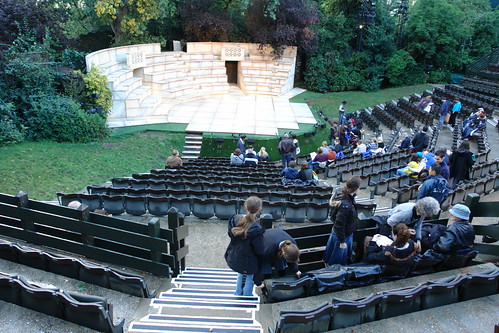Last year, I watched two different productions of A midsummer night’s dream – the first at the open air amphitheatre of Regent’s Park in London. It was midsummer, the perfect setting for that play and just the perfect play for that setting – the trees rustling above, doves flying, the sun shining on well into the performance (which started at 8 p.m.) as it slowly turned cool and then cold… I sat, shivering in the London night air watching the fairies with their lutes and flutes, their laughter ringing in my ears as they ran in and out of the open stage… listening to the music fill the air… the actors in their suits and gowns and the clipped British accents.
Just as Shakespeare would have had it perhaps?
“It shocks me that there are Londoners who have never been to a Regent’s Park Open Air Theatre performance of A Midsummer Night’s Dream – this is one of the great and simple rituals of London life†– Alistair McAuley, Financial Times, 2006.
Yes, it shocks me too.
And in January this year, the same play in Mumbai, but different in every way – with a British director and a South Asian crew speaking not just Shakespeare’s English but Tamil, Sinhala, Malayalam and three more languages. Not attired in plaids and pastels but in shiny silks and deep reds of the subcontinent…
If in 2006 Vishal Bharadwaj transported “Othello†into the brown badlands of Uttar Pradesh with his film Omkara, British director Tim Supple’s production of “A Midsummer Night’s Dream†could easily have been set in some mythical forest in the Vindhyas. Why, it could even have been an untold canto from the Aranyakanda of Ramayana, with Shakespeare’s fairies as lively vanaras, and Puck a young, playful Hanuman himself. In the true spirit of free creatures of the forest, Supple’s creatures indulge in acrobatic feats, climb up ladders and shimmy down ropes, roll in the mud and jump in the air.

[image courtesy : British Council website]
What contributes a lot in this is the extensive use of color in an otherwise barebones set. Visually arresting single tones have been used to their best effect; a deep red runs through the performance. In the long satiny womb that Titania ensconces herself into as she drifts into sleep, that becomes at once a swing in the middle of the forest and a thooli (makeshift cloth cradle) in the heart of the home.

[image courtesy : British Council website]
Here is my review Southasian Shakespearewallah for Himal.


i am so envious. i would love to have seen them both!